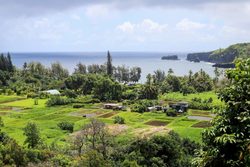Civil Beat | 1 August 2022
Should Maui County take over water long controlled by private companies?
By Marina Starleaf Riker
The kalo farmer from East Maui had fought on the frontlines of the Vietnam War, and now he was back home battling for a basic human right: water.
Ed Wendt was up against more than a century-old status quo in which the government permitted a plantation owned by Alexander & Baldwin to suck water from streams in his home on the lush east side of Maui and funnel it miles away to irrigate the ever-thirsty sugar cane fields in the central valley.
The sugar plantation was never supposed to take so much that communities like Wendt’s lost their source of water. But by the 1990s, streams ran dry. Native plants and animals that once flourished in delicate ecosystems disappeared. Families lost water needed to irrigate kalo fields that their ancestors had tended for generations, and some were forced to give up farming and move away.
Wendt knew he was up against a behemoth when he and other farmers launched their first legal battle with A&B in the early 2000s, a fight that would take them to the highest levels of Hawaii government. But over the years, their victories mounted. And now, almost 150 years after the plantation first started tapping the streams, he and other community members have helped bring Maui to what could be a historic turning point.
In November, voters will decide whether to create a new government entity, under the oversight of East Maui citizens, that will be tasked with taking back control of water long held by one of Hawaii’s most powerful corporations.
A&B isn’t the only one with a stake in East Maui Irrigation, the company that runs the ditches and reservoirs originally built to feed sugar cane. In 2019, EMI took on a new owner, Mahi Pono, a company backed by a California agribusiness and one of Canada’s largest pension funds. In recent years, the pension fund has poured millions of dollars into buying up water rights across the globe.
On Maui, Mahi Pono purchased 41,000 acres of A&B’s former sugarcane fields after the plantation shut down — along with half of the ownership of EMI, which includes another 15,000 acres. Right now, those companies are in the process of trying to keep control of the water that flows from East Maui streams for another 30 years.
“The goal is to see this area protected for future generations and not let a foreign entity manage our resources,” Wendt said. “That’s the worst damn thing that can happen.”
In the Nov. 8 general election, Maui County voters will decide via a charter amendment question whether the county should be able to create new entities called “water authorities.” The first one would be established in East Maui, and the county would one day be able to establish regional water authorities across Maui, Molokai and Lanai.
For everyone involved, the stakes are high. In its sales agreement, A&B promised it would repay Mahi Pono up to $62 million if it didn’t succeed in helping the new company hold onto water leases. Maui County’s Department of Water Supply, meanwhile, has warned about the financial toll that might come with taking on the antiquated water system that’s leaking an untold number of gallons each day. Some also say that standing up a new government agency is premature, without knowing exactly what it will cost and how it’ll work with the existing water department.
In a heated election year, it’s also become a rallying point for candidates trying to win votes. Over the last couple months, dozens of people have packed meetings and written to the County Council. They include residents urging officials to safeguard the resource for Upcountry’s small farmers frequently struggling with drought.
Then there are the parents who worry there won’t be enough left for their children and grandchildren, unless more is done to protect the supply now. Others say it all comes down to one simple question: Should Maui control its own water future?
Water and Politics
For centuries, Native Hawaiian communities viewed water as a shared and sacred resource. That perspective has been ingrained in Hawaii’s laws since before the 1893 overthrow of the monarchy, an action backed by plantation owners. Today, water is still protected as a public trust, meaning the state is charged with protecting water for the benefit of all people. Unlike in other states, water rights in Hawaii can’t be bought or sold; instead, the government may allow companies to lease it.
But for much of the 20th century, plantations held so much political power that their businesses were given priority over the water supply. They controlled it, largely without question, for decades — along with almost everything else about daily life, such as how people worked, where they lived and who they were urged to elect into government.
But as early as the 1960s, some Maui County leaders were sounding the alarm. Water shortages were stalling development. Communities like Kula, Haiku, Paia and Makawao were “very dependent” on EMI, which ran 24 miles of irrigation ditches and 50 miles of tunnels and reservoirs that channeled stream water to the sugar plantation, homes and businesses. Since Maui County didn’t run the system, it depended on buying water from the company.
But 60 years later, EMI still controls the East Maui water leases. The county still depends on the private company to supply a portion of the water that serves Upcountry homes and farms. And the company is once again trying to hold onto the supply — this time in the form of a 30-year lease, which is exactly what some people want to see stopped.
Some residents and local government leaders have been urging the county to take a more active role in managing the water. Although a private company built the EMI system, most of the water it taps comes from 33,000 acres of state-owned land.
In January, both the County Council and the Board of Water Supply formally urged Mayor Michael Victorino to pursue the state’s 30-year leases for East Maui stream water. Only the county administration, not the council or the water board, can officially ask the state to take over the water leases.
Months went by, and nothing changed. So council members, led by Hana’s Shane Sinenci, set another strategy: Ask the voters if they want to allow Maui County to create new regional agencies that could be tasked with overseeing streams and watersheds and ensuring that communities and natural ecosystems have a safe and abundant supply.
The new water authorities would work alongside existing county departments, which have been wary of taking on years of backlogged maintenance that comes with century-old, plantation-era water systems. The proposal has garnered widespread community support, especially among residents who warn what will happen in the future if nothing is done.
“We’ll be fighting over less and less water,” said Lucienne de Naie, a longtime conservation champion on Maui. “And some of that water probably will be in the hands of people who want to make money from it.”
It’s become a hot topic this election season. Council members Alice Lee and Yuki Lei Sugimura were the only two who voted against putting it on the ballot. In a recent opinion piece published in the Maui News, Sugimura advocated for more vetting before pushing the proposal forward, saying that it’s “unclear how the water authority’s role would mesh” with the existing county water department and state Commission on Water Resource Management.
Meanwhile, council members Kelly King and Mike Molina, both of whom are running for mayor, have long advocated for taking back control of Maui’s water sources. Political newcomers Kim Brown and Cullan Bell are also vocal proponents. In recent weeks, the other two mayoral frontrunners — former Judge Richard Bissen and Victorino — announced their support.
For some who’ve watched the situation unfold, Victorino’s endorsement during a public candidate forum came as a surprise, since the county has always had the power to ask the state for the water leases at any time, even without the creation of a water authority. The mayor’s office did not respond to a request for an interview.
There have been, however, major voices missing in the months of public meetings, particularly Mahi Pono and A&B. Although county leaders have said they want to work with Mahi Pono and see its farming venture succeed, it’s unclear how the proposal might affect its business. Mahi Pono did not respond to Civil Beat’s requests for comment, and A&B declined an interview.
“We’ve always extended our invitation to A&B and Mahi Pono, and they haven’t taken any of our invitations,” Sinenci told county officials during a recent meeting. “We haven’t heard anything from them.”
Commodity Or Public Trust?
Throughout all the meetings, there has been one steady force of opposition: the county’s own water department.
Forty-eight hours after Victorino publicly pledged his support, the water department’s deputy director cautioned the Maui County Council against moving forward. At a July 15 meeting, Shayne Agawa, who assumed his role earlier this spring, compared the county involving itself with the aging water system to buying a used car without knowing what maintenance is required.
But one council member questioned if the water department’s hesitancy came down to something more fundamental. Asked if the department believed water was a public trust, Agawa replied that was a “tough question.”
“I believe water is a commodity for public use,” he continued.
Mahi Pono has planted crops including oranges, limes and coffee on old sugar cane land along Haleakala Highway on Maui.
Marina Riker/Civil Beat/2022
According to Mahi Pono, the cost to maintain the EMI system is at least $1.5 million per year. But before taking an interest in it, county water department leaders want to study exactly what it would take to run it. The Board of Water Supply put together a similar study in 2019, but department leaders say they want a new one of their own.
By EMI’s own estimate, at least one-fifth of the water it takes from streams is lost because of leaks in its system. At the same time, if Maui wants to focus on boosting long-term water security, it needs to invest in pumping water from the ground, Helene Kau, water department director, told Civil Beat.
Kau was appointed by Victorino as the department director this spring, inheriting a water department that serves communities frequently grappling with drought and water shortages. Last year, Maui made national headlines when only Upcountry residents were ordered to conserve water or face $500 fines, but not resort communities in Wailea.
That inequity exists because of the way Maui’s water systems were originally built: In the 1970s, developers like A&B partnered with the county to build a pipeline to pump underground water from Central Maui to the developing resort destination. Decades later, the county is still struggling to find reliable sources for Upcountry, because the region relies on an entirely separate water system that depends on stream water, which is more vulnerable to drought.
Wailea in south Maui
South Maui has a more reliable supply of water than Upcountry because of the way Maui’s water systems were originally built.
Nathan Eagle/Civil Beat/2022
But even when there’s been a desire to take on new projects, recent attempts to take over privately owned water systems have failed. Earlier this year, the county tried to purchase another plantation-era system, Wailuku Water Co., Maui Now reported. But the company’s president said the county wasn’t serious enough, and the deal fell through.
Voters could decide to create a new government entity tasked with trying to take over those systems. Water department officials, however, worry that for now, there are too many unknowns — like whether a new agency would realistically be able to depend on grant funding and how much it would all cost.
“I think that adding another layer of government decision-making, and to some degree bureaucracy, doesn’t guarantee that we’re going to achieve the results that people are looking for,” Kau said.
Residents Move To Regain Control
To some degree, Amanda Martin understands where officials are coming from. Her roots are in Ke‘anae, but for almost 30 years, she worked for the county too. She started in the 1990s when council member Alice Lee was first elected to the council and ended in 2016 with Gladys Baisa.
“It took a long time for me to understand, get educated and realize what was happening,” Martin said. “All these years, including when I was there … we turned our back to this community. To our own people. To my ohana.”
“We cannot do that anymore,” she said.
In East Maui, a group of residents is now in charge of measuring steam flow after it was awarded a grant from the federal government.
Marina Riker/Civil Beat/2022
Today, she’s one of the members of Na Moku Aupuni O Ko‘olau Hui, the group of East Maui residents who fought for water under Wendt’s leadership. Martin is still angry that the county, state agencies and lawmakers allowed A&B to starve their community of water for so long, forcing residents into years of legal battles. But she also knows that recently, more of the people in power are listening.
Jerome Kekiwi Jr. and Amanda Martin of Na Moku Aupuni O Koʻolau Hui pose for a portrait in front of their community center in Keʻanae.
Marina Riker/Civil Beat/2022
And if the voters decide to create the water authorities, Martin said, communities like hers will be guaranteed a seat at the table. Under the proposal, the first water authority in East Maui would be managed by an 11-member board, at least eight of whom must be residents of the community. They’d be the ones in charge of picking the director of the water authority — not the mayor.
That means farmers who’ve fought for water there for decades would finally have the chance to oversee how the system is run; so, too, would other residents who still live on their ancestral lands and hold generational knowledge of the mountains, streams and sea.
“It’s important that the people of the community manage their own system,” Martin said.
On a rainy morning earlier this month, Martin sat with Wendt and another kalo farmer in the same community center overlooking the Ke‘anae peninsula, where their elders first met and discussed launching the battle against the sugar plantation long ago. Dark clouds rolled across the horizon as Wendt, now 73, spoke to the next generation of community leaders.
“This is our home,” Wendt told them.
“Our elders paved the trail,” he said. “Now it’s your turn to take it to the next level.”
Civil Beat’s coverage of Maui County is supported in part by grants from the Nuestro Futuro Foundation and the Fred Baldwin Memorial Foundation.














